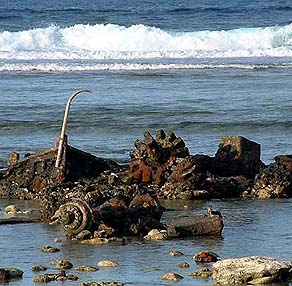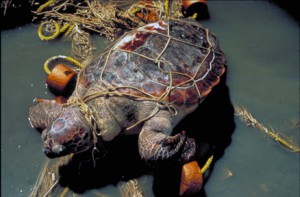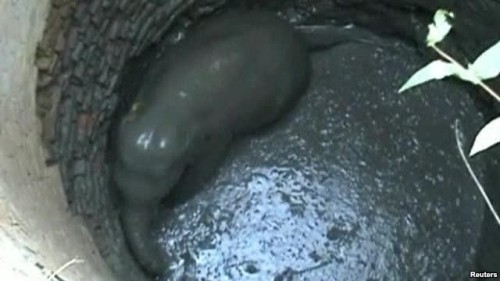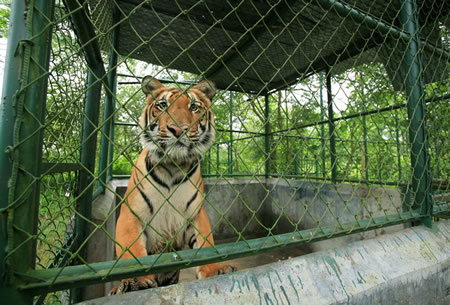 It might be peace time on dry land but the inhabitants of seas and oceans are constantly at war with armed forces of the world as they struggle with the military debris thrown into the waters. More often than not, the living species are miserably losing the battle of life.
It might be peace time on dry land but the inhabitants of seas and oceans are constantly at war with armed forces of the world as they struggle with the military debris thrown into the waters. More often than not, the living species are miserably losing the battle of life.
Many experts globally have shown that military debris thrown into oceans is potentially hazardous to the marine population. Turtles, corals, whales, sharks, the list of animals that have been harmed by coming in contact with the debris are endless. What the recent Japan Tsunami also points out is that it is very easy for this debris to wash ashore and bring with itself a calamity that is much fiercer than the giant Tsunami waves.
According to Ryo Sato, marine researcher at Global Green, the U.S. affiliate of the NGO Green Cross International,
“The tsunami from the Japan earthquake increased the likelihood of sea dumped conventional and chemical weapons washing ashore as they rest at a shallow depth of 200 metres in Choshi Bay of Chiba Prefecture in Japan.”
It is a world problem of a gigantic proportion. France, USA, Australia, Russia even India has thrown away military waste in marine waters that have turned harmful for the species living in the water and are continuing to harm them.
Glimpse of the World Scenario
The scenario is shocking all across the world, The Baltic Sea, North Atlantic Ocean, Mediterranean Sea, and Pacific Ocean are all hazardous dumping grounds.
- Around 300,000 tonnes of chemical warfare agents were dumped in oceans from 1946 to 1965.
- The U.S. Army dumped over 8,000 tonnes of chemical weapons off Hawaii
- Upwards of 400,000 gas filled-bombs and rockets float in U.S. waters
- 40,000 tonnes of Conventional Weapons (CW) are in the Baltic Sea
- 21,000 tonnes of CW agents float in Australian waters
- More than 6,600 tonnes of Chemical weapons float on the coast of Japan
- France conducted 137 undersea nuclear tests between 1975 and 1996 in French Polynesia creating an artificial crater 140 metres in diameter – disturbing one million cubic metres of coral and sand. The radioactive materials continue to leach.
“Marine debris… adversely impacts marine life, destroys habitat and entangles food for marine organisms and seabirds,” says Finn Longinotto, senior programme fellow at Global Green.
Apart from the residual debris, there are also the harm done to marine life through missiles, submarines or torpedoes that emit sonar waves and harm the hearing ability of animals like dolphins, whales and dugongs. The drastic affects forever destroy their ability to hunt, communicate in a group, migration, and mating behaviour.
India’s Concern
 India’s Defence Research and Development Organisation (DRDO) has from time to time been blamed by conservationist with destruction of fragile ecosystem in the Bay of Bengal especially in threatening the nesting sites of Olive Ridley Turtles within the Gahirmatha Marine Sanctuary in Orissa.
India’s Defence Research and Development Organisation (DRDO) has from time to time been blamed by conservationist with destruction of fragile ecosystem in the Bay of Bengal especially in threatening the nesting sites of Olive Ridley Turtles within the Gahirmatha Marine Sanctuary in Orissa.
“DRDO is not supposed to carry out missile testing during the turtle nesting season. However, they flout this rule despite regular forest department objections,” charges Biswajit Mohanty, of the Wildlife Society of Orissa.
“In one recent incident, the missile misfired, resulting in the destruction of the turtle nesting habitat in Nasi Island inside the Gahirmatha Marine Sanctuary – a breeding ground for olive ridley turtles. The vibration coming from missile launches being almost equal to seismic intensity can have an impact on the fragile eggs, we still don’t know scientifically what happens as an impact on the eggs,” Mohanty added. “The DRDO is insensitive that the state’s unique natural heritage – olive ridley turtles – might abandon the nesting grounds if the missile activity disturbs them.”
The DRDO spokespersons however stress that they take full precautions before any missile testing.
“DRDO takes due care to avoid any adverse effect on eco-system while planning and conducting missile tests from DRDO ranges. The launching pad has been designed in such a manner that it does not affect the fauna and flora of that area or cause any adverse effect on the environment.”
In another coastal part of the country, the Netrani Islands off the coast of Karnataka are known for being home to the white bellied sea eagle, corals, coral fish, whale shark, tiger shark, giant groupers, giant clam, dolphins, sea snakes, crustaceans, reef sharks, stingrays, squid, sea cucumbers olive ridley turtles, jelly fish, sea urchins, killer whales and edible nest swiftlets.
But here too naval firing is posing a threat to the ecosystem. According to V. N. Nayak, marine biologist at Karnataka University, large number of bullets, bombs, torpedos and missiles are found in an around the island, fired by the navy using the island as a ‘target practice’ station.
The navy does agree to the use of the island for training session but says it is an important military exercise that cannot be ignored.
“Naval firing practices are periodically conducted on a 16-metre barren rock, located close to Netrani Island,” the Indian Navy says. “Such firing practices have been conducted for the last six decades.” With chances of an outbreak of hostilities stemming from the terrorist attacks in Mumbai “the necessity for the Indian Armed Forces to remain combat-ready… at all times can hardly be over-emphasised. It is precisely this realisation that has already led the Karnataka Biodiversity Board to drop the proposal to consider Netrani Island a Biodiversity Park.”
It is a dilemma perhaps of every modern nation of the world. To be war-time ready, at all times also means to be a constant threat to wildlife and creatures that live around testing grounds. The species are always under attack, their homes are always too close to enemy lines. As oceans become military dustbins, the number of innocent causalities only keeps increasing.
– Atula Gupta
Article reference: IPS
Related Stories:






3 thoughts on “Military Debris Threatening Marine Life and Oceans”